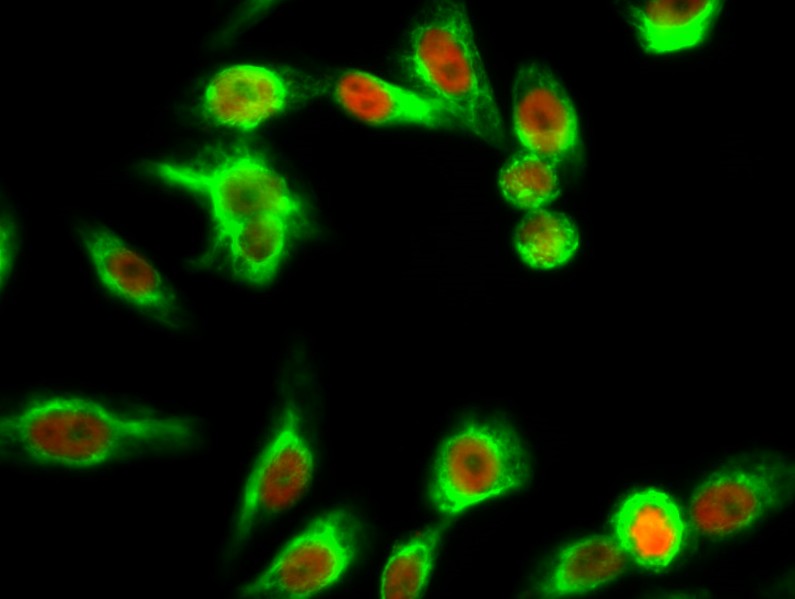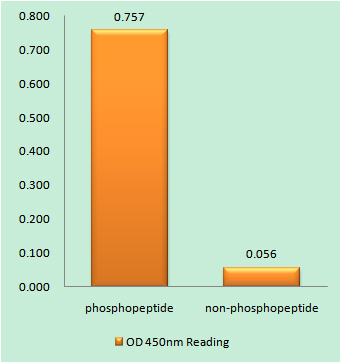LKB1 (phospho Ser428) Polyclonal Antibody
- Catalog No.:YP0900
- Applications:WB;IHC;IF;ELISA
- Reactivity:Human;Mouse;Cow
- Target:
- LKB1
- Fields:
- >>FoxO signaling pathway;>>Autophagy - animal;>>mTOR signaling pathway;>>PI3K-Akt signaling pathway;>>AMPK signaling pathway;>>Longevity regulating pathway;>>Tight junction;>>Adipocytokine signaling pathway
- Gene Name:
- STK11
- Protein Name:
- Serine/threonine-protein kinase STK11
- Human Gene Id:
- 6794
- Human Swiss Prot No:
- Q15831
- Mouse Gene Id:
- 20869
- Mouse Swiss Prot No:
- Q9WTK7
- Immunogen:
- The antiserum was produced against synthesized peptide derived from human LKB1 around the phosphorylation site of Ser428. AA range:384-433
- Specificity:
- Phospho-LKB1 (S428) Polyclonal Antibody detects endogenous levels of LKB1 protein only when phosphorylated at S428.
- Formulation:
- Liquid in PBS containing 50% glycerol, 0.5% BSA and 0.02% sodium azide.
- Source:
- Polyclonal, Rabbit,IgG
- Dilution:
- WB 1:500 - 1:2000. IHC 1:100 - 1:300. IF 1:200 - 1:1000. ELISA: 1:40000. Not yet tested in other applications.
- Purification:
- The antibody was affinity-purified from rabbit antiserum by affinity-chromatography using epitope-specific immunogen.
- Concentration:
- 1 mg/ml
- Storage Stability:
- -15°C to -25°C/1 year(Do not lower than -25°C)
- Other Name:
- STK11;LKB1;PJS;Serine/threonine-protein kinase STK11;Liver kinase B1;LKB1;hLKB1;Renal carcinoma antigen NY-REN-19
- Observed Band(KD):
- 65kD
- Background:
- This gene, which encodes a member of the serine/threonine kinase family, regulates cell polarity and functions as a tumor suppressor. Mutations in this gene have been associated with Peutz-Jeghers syndrome, an autosomal dominant disorder characterized by the growth of polyps in the gastrointestinal tract, pigmented macules on the skin and mouth, and other neoplasms. Alternate transcriptional splice variants of this gene have been observed but have not been thoroughly characterized. [provided by RefSeq, Jul 2008],
- Function:
- catalytic activity:ATP + a protein = ADP + a phosphoprotein.,cofactor:Magnesium or manganese.,disease:Defects in STK11 are a cause of Peutz-Jeghers syndrome (PJS) [MIM:175200]. PJS is a rare hereditary disease in which there is predisposition to benign and malignant tumors of many organ systems. PJS is an autosomal dominant disorder characterized by melanocytic macules of the lips, multiple gastrointestinal hamartomatous polyps and an increased risk for various neoplasms, including gastrointestinal cancer.,disease:Defects in STK11 have been associated with testicular tumors [MIM:273300]. It includes germ cell tumor (GCT) or testicular germ cell tumor (TGCT).,enzyme regulation:Activated by binding of a complex consisting of CAB39 and STRAD or CAB39 and ALS2CR2.,function:Essential role in G1 cell cycle arrest. Phosphorylates and activates members of the AMPK-related subfamily of protein ki
- Subcellular Location:
- Nucleus. Cytoplasm. Membrane . Mitochondrion. A small fraction localizes at membranes (By similarity). Relocates to the cytoplasm when bound to STRAD (STRADA or STRADB) and CAB39/MO25 (CAB39/MO25alpha or CAB39L/MO25beta). Translocates to the mitochondrion during apoptosis. PTEN promotes cytoplasmic localization. .; [Isoform 2]: Nucleus . Cytoplasm . Predominantly nuclear, but translocates to the cytoplasm in response to metformin or peroxynitrite treatment.
- Expression:
- Ubiquitously expressed. Strongest expression in testis and fetal liver.
Virus-mediated decrease of LKB1 activity in the mPFC diminishes stress-induced depressive-like behaviors in mice. BIOCHEMICAL PHARMACOLOGY Biochem Pharmacol. 2021 Dec;:114885 IF Mouse 1:100 Brain
Rg1 Attenuates alcoholic hepatic damage through regulating AMP-activated protein kinase and nuclear factor erythroid 2-related factor 2 signal pathways. JOURNAL OF ASIAN NATURAL PRODUCTS RESEARCH 2016 May 26 WB Mouse liver
Blockage of EGFR/AKT and mevalonate pathways synergize the antitumor effect of temozolomide by reprogramming energy metabolism in glioblastoma Cancer Communications Xiaoteng Cui WB Human 1:500 TBD0220 cell,U-87 MG cell
- June 19-2018
- WESTERN IMMUNOBLOTTING PROTOCOL
- June 19-2018
- IMMUNOHISTOCHEMISTRY-PARAFFIN PROTOCOL
- June 19-2018
- IMMUNOFLUORESCENCE PROTOCOL
- September 08-2020
- FLOW-CYTOMEYRT-PROTOCOL
- May 20-2022
- Cell-Based ELISA│解您多样本WB检测之困扰
- July 13-2018
- CELL-BASED-ELISA-PROTOCOL-FOR-ACETYL-PROTEIN
- July 13-2018
- CELL-BASED-ELISA-PROTOCOL-FOR-PHOSPHO-PROTEIN
- July 13-2018
- Antibody-FAQs
- Products Images

- Immunofluorescence analysis of Hela cell. 1,LKB1 (phospho Ser428) Polyclonal Antibody(red) was diluted at 1:200(4° overnight). NSE Monoclonal Antibody(13E2)(green) was diluted at 1:200(4° overnight). 2, Goat Anti Rabbit Alexa Fluor 594 Catalog:RS3611 was diluted at 1:1000(room temperature, 50min). Goat Anti Mouse Alexa Fluor 488 Catalog:RS3208 was diluted at 1:1000(room temperature, 50min).

- Enzyme-Linked Immunosorbent Assay (Phospho-ELISA) for Immunogen Phosphopeptide (Phospho-left) and Non-Phosphopeptide (Phospho-right), using LKB1 (Phospho-Ser428) Antibody

- Immunofluorescence analysis of NIH/3T3 cells, using LKB1 (Phospho-Ser428) Antibody. The picture on the right is blocked with the phospho peptide.

- Immunohistochemistry analysis of paraffin-embedded human colon carcinoma, using LKB1 (Phospho-Ser428) Antibody. The picture on the right is blocked with the phospho peptide.

- Western blot analysis of lysates from HeLa cells treated with PMA 125ng/ml 30', using LKB1 (Phospho-Ser428) Antibody. The lane on the right is blocked with the phospho peptide.



